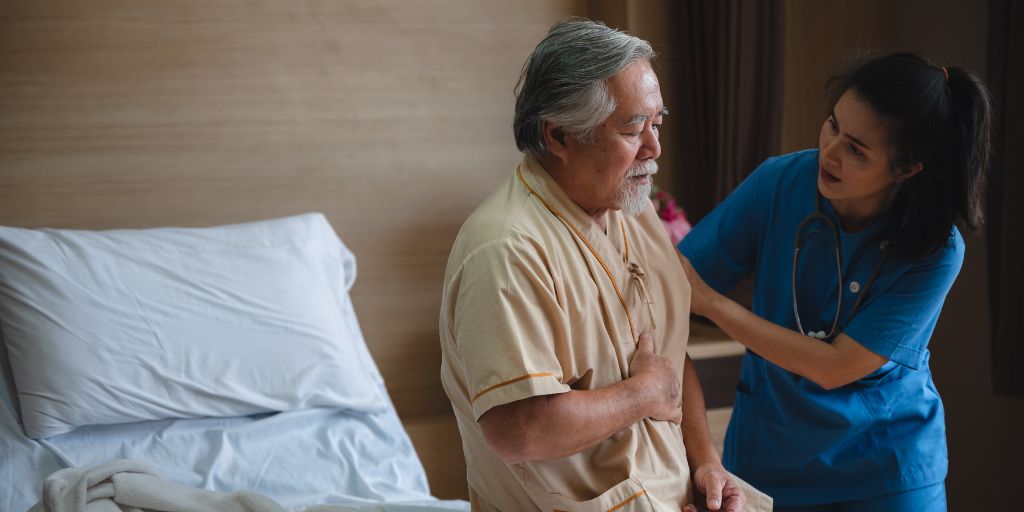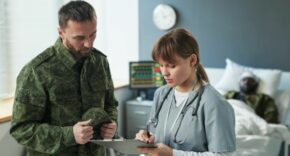
Stroke rehabilitation staff at NCIC are leading the way in implementing new stroke guidelines that emphasise the need to increase opportunity to take part in rehabilitation.
New guidelines released in April this year meant that the team needed not only to increase the amount of rehabilitation that they offered patients but also the way they delivered it. The team at Carlisle are one of the first in the country to adopt the new guidelines.
The difference to patients has been remarkable.
Kathleen Potts from Carlisle, had a stroke at the beginning of April. Immediately after the stroke. The 86 year old lost all ability to speak and the use of her entire right side. She needed to be hoisted in and out of bed and needed a specialised chair to sit in when she wasn’t in bed.
Now around 8 weeks later she has regained most of her speech, although some letters and words still test her, and she is walking with an aid to the gym for her rehabilitation.
She is a very determined women but had every praise for the team as she tearfully said:
“I think they are truly wonderful, every one of them. They have helped me so much. Today I practiced getting into bed and turning over as well as going from lying down to sitting up and getting my legs over the side. I find it really hard because my right side is still weak but I’m getting there.
“I practice following a line on a wooden board on my knee when I’m sitting in my chair – a few weeks ago I couldn’t keep my finger on the line and I can now. I find it hard to grip on my right hand side but I keep practicing and it will come.
“A few weeks ago I couldn’t speak at all and it has come back but I still struggle with certain sounds and letters. It’s really frustrating because up here [points to her head] I know what I want to say but it doesn’t come out properly.
“Now I can walk with a walking aid and I hope that I will be going home soon. I am determined but I couldn’t have done it without the team helping me. Also the students have been excellent – Archie, George and Selen. I’m looking forward to sitting in the sun under my parasol in the garden at home.”
Alan Blaylock is 80 and from Carlisle. He had a stroke around 12 weeks ago. Initially he was extremely ill and had to be fed through a tube, he also needed to be hoisted in and out of bed, lost most of his speech and the use of his right hand side. Now he is able to walk with an aid and regularly has rehabilitation which he really enjoys.
He was very emotional as he explained:
“I’m still weak but I can do a lot of things now. The team and everyone here are excellent. 10 weeks ago if you had told me where I am now I would have honestly told you that was impossible. I am really proud of myself. My son Paul, granddaughter Kelsey and my wife Susan come to see me regularly and they see a difference every time. That has spurred me on too and I am so very grateful for their support. It’s been a really difficult time.
I hope to be going home in a few weeks and I’m looking forward to cooking mince and tatties. In the last two weeks I have been able to go outside in my wheelchair and the staff say I’ve got a lovely tan now! I would really like to thank each staff member individually they have all been wonderful, I can’t do that but I would like to say particular thanks to Kim and Faye who are wonderful.”
One of the main differences to changing the stroke rehabilitation is the amount of rehabilitation that the patient can do when the staff are not there, they get rehabilitation while they are in their beds and while they are sitting in their chairs.
Dawn Lamb Advanced Specialist Physiotherapist explained:
“We have known for some time that the new stroke guidelines would recommend increasing the opportunities and time for patients to take part in task specific rehabilitation after stroke. This is a challenging change but one that the whole team has given a huge amount of time, thought and training to address. We have adapted the way we work to ensure patients have individualised rehabilitation exercise plans that start on the hyper acute stroke unit.
“The patients take part in daily practice at bedside with things such as getting washed and dressed, eating and drinking more independently. In a semi-supervised gym setting where they can use the gym equipment to target specific muscle groups; we also have active lunch and breakfast activities which means patients are supported to use cutlery in both hands and drink independently. We have increased the minutes of therapy delivered to patients by 33% since February 22.
“Before these changes Kathleen and Alan would be more likely to be less independent when they go home. There is a great vibe on the ward because staff can see results and so can patients. Every patient will recover differently but we are seeing people gaining more independence quicker than we were.”
The change in practice involved a huge amount of collaborative working across the stroke services in north Cumbria. Training needs were addressed by using funding from Health Education England and, using the stroke charitable funds, we bought some essential new equipment such as a motomed cyclometer (a kind of exercise bike that you can use in a wheelchair for legs and arms) a standing frame and a number of electrical muscle stimulators which have been found to help muscles recover after stroke.
The guidelines recommend patients spend time imagining their affected limb is moving if it is really weak. Clinical psychology and physiotherapists have collaborated to provide patients and families supporting patients with mental imagery practice recordings.
Dawn added:
“We also bought new specialist chairs so that patients can sit out of bed sooner after stroke. Students have also became an integral part if the team, joining the unit in small groups with a coaching approach to their practice placement.
“Staff are noticing improvements in patient’s functional abilities sooner after stroke and are motivated to keep improving the opportunities patients have to practice tasks and exercise as much as possible. This has been a whole team approach to improving rehabilitation after stroke and patients are positive about their rehabilitation experience, they can’t wait to get to the gym.”











